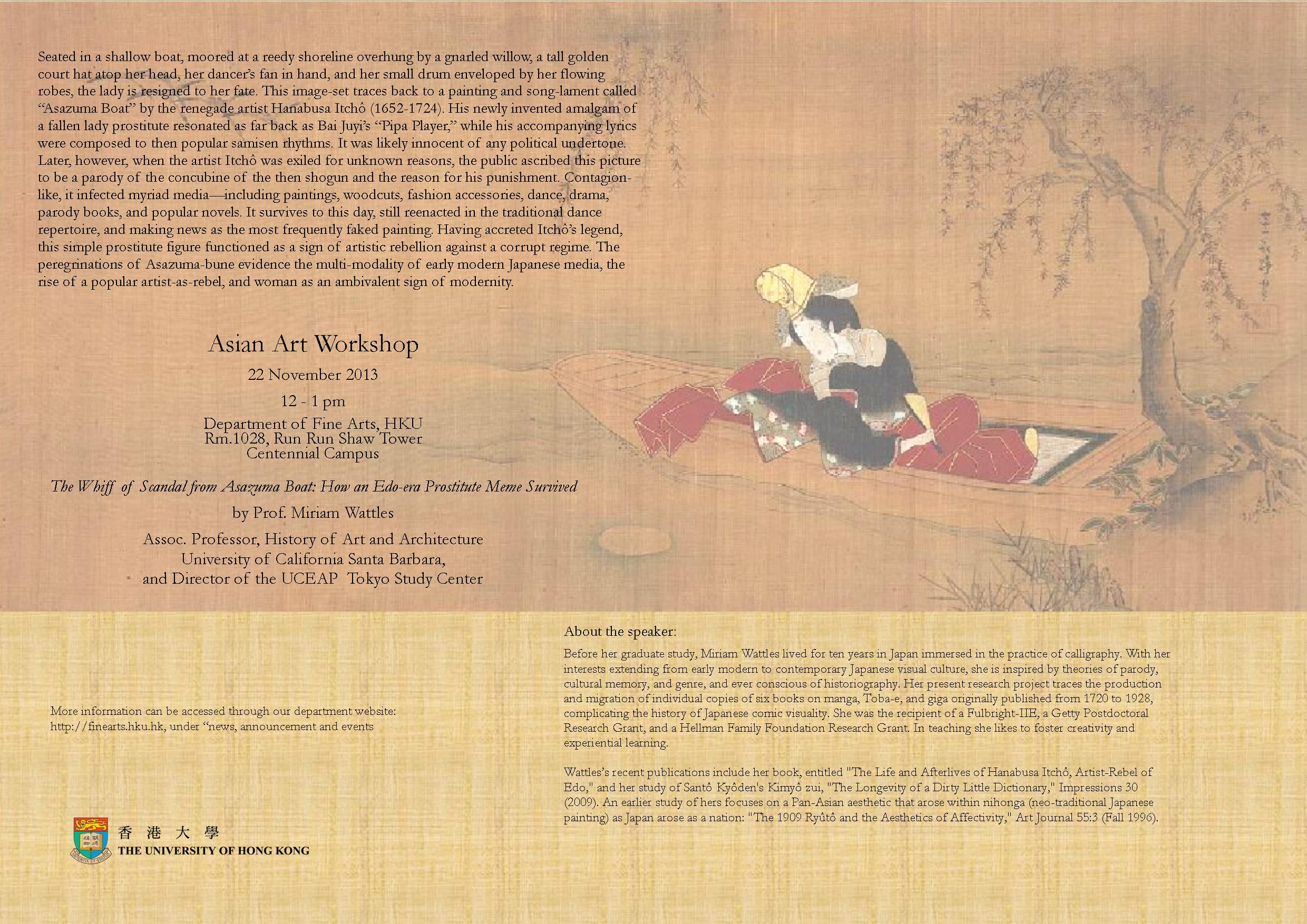

The Whiff of Scandal from Asazuma Boat
November 22, 2013 @ 12:00 pm - 1:00 pm
Asian Art Workshop: The Whiff of Scandal from Asazuma Boat: How an Edo-era Prostitute Meme Survived
Date: 22 November 2013 (Friday)
Time: 12:00-1:00pm
Venue: Room 10.28, Run Run Shaw Tower, Centennial Campus
Seated in a shallow boat, moored at a reedy shoreline overhung by a gnarled willow, a tall golden court hat atop her head, her dancer’s fan in hand, and her small drum enveloped by her flowing robes, the lady is resigned to her fate. This image-set traces back to a painting and song-lament called “Asazuma Boat” by the renegade artist Hanabusa Itchō (1652-1724). His newly invented amalgam of a fallen lady prostitute resonated as far back as Bai Juyi’s “Pipa Player”, while his accompanying lyrics were composed to then popular samisen rhythms. It was likely innocent of any political undertone. Later, however, when the artist Itchō was exiled for unknown reasons, the public ascribed this picture to be a parody of the concubine of the then shogun and the reason for his punishment. Contagion-like, in infected myriad media – including paintings, woodcuts, fashion accessories, dance, drama, parody books, and popular novels. It survives to this day, still reenacted in the traditional dance repertoire, and making news as the most frequently faked paintings. Having accreted Itchō’s legend, this simple prostitute figure functioned as a sign of artistic rebellion against a corrupt regime. The peregrinations of Asazuma-bune evidence the multi-modality of early modern Japanese media, the rise of a popular artist-as-rebel, and woman as an ambivalent sign of modernity.
Speaker: Miriam Wattles
Before her graduate study, Miriam Wattles lived for ten years in Japan immersed in the practice of calligraphy. With her interests extending from early modern to contemporary Japanese visual culture, she is inspired by theories of parody, cultural memory, and genre, and ever conscious of historiography. Her present research project traces the production and migration of individual copies of six books on mange, Toba-e, and gigs originally published from 1720 to 1928, complicating the history of Japanese comic visuality. She was the recipient of a Fulbright-IIE, a Getty Postdoctoral Research Grant, and a Hellman Family Foundation Research Grant. In teaching she likes to foster creativity and experiential learning.
Wattle’s recent publications include her book, entitled The Life and Afterlives of Hanabusa Itchō, Artist-Rebel of Edo, and her study of Santō Kyōden’s Kimyō zui, The Longevity of a Dirty Dictionary, Impressions 30 (2009). An earlier study of hers focuses on a Pan-Asian aesthetic that arose within nihonga (neo-traditional Japanese painting) as Japanese arose as a notion: The 1909 Ryutō and the Aesthetics of Affectivity, Art Journal 55:30 (Fall 1996).



Find us on…